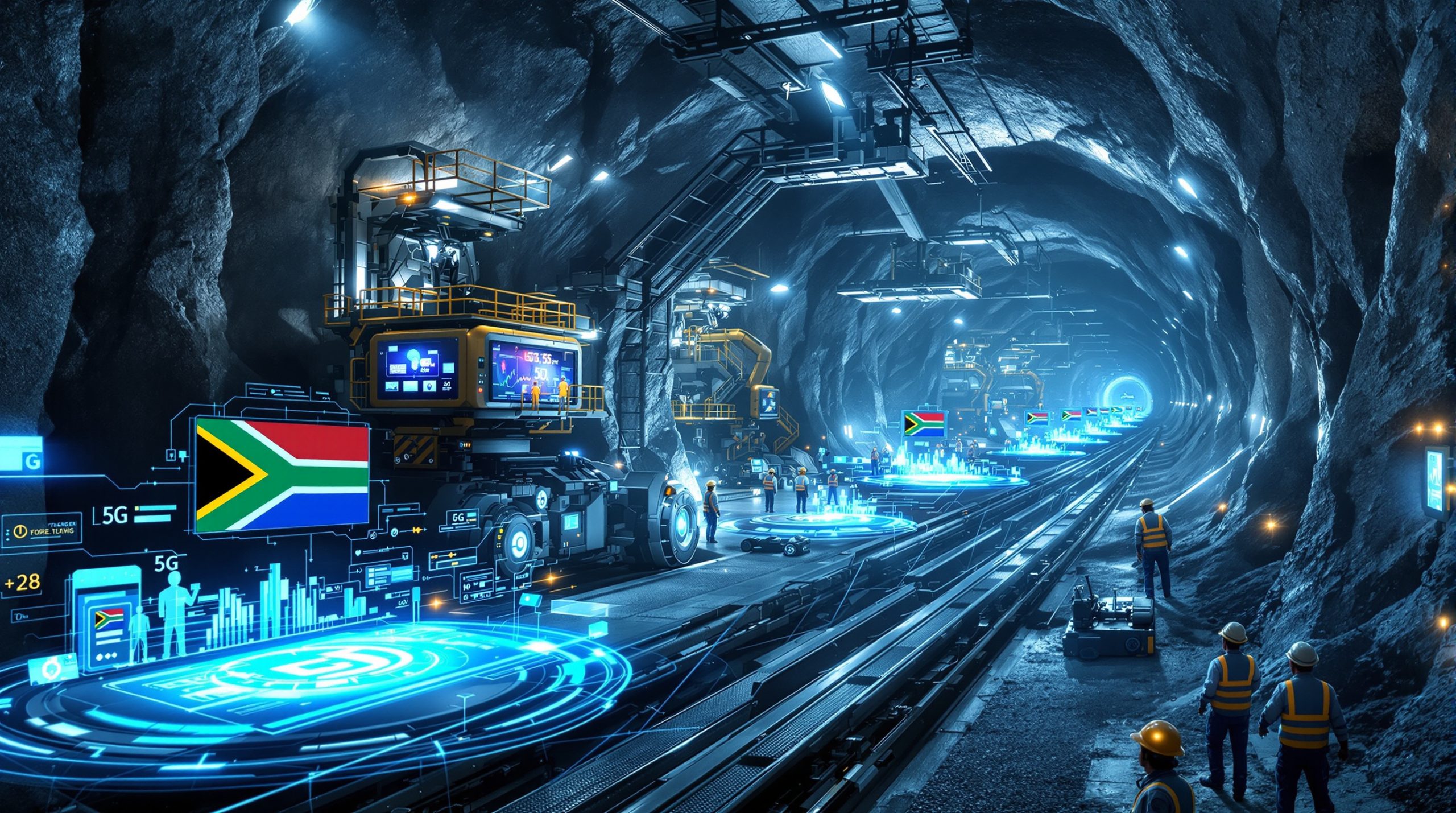Understanding the Troilus-Aurubis Copper-Gold Offtake Agreement: Strategic Implications for Global Supply Chains
The mining sector recently witnessed a significant strategic partnership with the formalization of the Troilus-Aurubis copper-gold offtake agreement. This landmark deal sets the stage for substantial copper-gold concentrate supply from Quebec to European markets, representing much more than a standard commercial arrangement. Let's explore the multifaceted implications of this partnership for global supply chains, market dynamics, and strategic mineral security.
What is the Troilus-Aurubis Offtake Agreement?
The Troilus-Aurubis copper-gold offtake agreement represents a forward-looking strategic partnership formalized through a Memorandum of Agreement (MoA) between Troilus Gold, a Canadian mining company, and Aurubis AG, a leading German copper smelter and recycler. This agreement establishes the framework for Troilus to supply copper-gold concentrate from its Quebec-based Troilus Project to Aurubis.
The MoA builds upon indicative terms announced earlier and advances the relationship between the two companies to a more concrete stage that outlines specific commercial terms for long-term concentrate supply. According to the agreement, Troilus Gold will deliver approximately 75,000 tonnes of copper-gold concentrate annually to Aurubis once production commences.
The significance of this partnership extends beyond commercial considerations, as evidenced by its high-profile diplomatic context. Industry analysts suggest the agreement includes standard elements such as long-term supply commitments, quality specifications, pricing mechanisms linked to metal benchmarks, logistics arrangements, and force majeure provisions.
For Troilus Gold, this agreement provides revenue certainty that enhances project bankability while securing a reliable customer for a significant portion of future production. For Aurubis, it ensures access to high-quality concentrate from a politically stable jurisdiction, diversifying their raw material sourcing strategy.
Why is the Troilus Project Strategically Important?
Project Scale and Resource Potential
The Troilus Project stands as one of Quebec's most significant mining developments, positioned to produce approximately 75,000 tonnes of copper-gold concentrate annually. Located in north-central Quebec, the project revitalizes a former producing mine that operated from 1996 to 2010, leveraging existing infrastructure while incorporating modern mining technologies.
With a projected 22-year mine life based on current reserves, the Troilus Project represents a long-term contributor to North American critical mineral production. The operation will utilize conventional open-pit mining methods to process approximately 50,000 tonnes of ore daily, yielding substantial quantities of copper, gold, and silver throughout its operational life.
The project's scale positions it as a significant player in the North American copper market, with production volumes sufficient to impact regional supply dynamics. Its polymetallic nature—producing copper, gold, and silver—provides natural hedging against price volatility in any single commodity, enhancing overall project resilience. The gold‑copper exploration activities continue to indicate substantial potential for resource expansion.
Infrastructure Advantages and Development Timeline
A crucial competitive advantage for the Troilus Project is its well-established infrastructure foundation, which significantly reduces development costs and timelines. The project benefits from:
- Existing access roads connecting to provincial highways
- Power transmission lines with substantial capacity
- Operational electrical substations
- Water management systems and permitted water rights
- Previously developed tailings storage facilities with expansion potential
- Brownfield development areas requiring minimal land disturbance
This infrastructure foundation dramatically reduces capital requirements compared to greenfield projects, potentially saving hundreds of millions in development costs. The project's advancement is proceeding alongside Troilus Gold's broader debt financing package of up to $700 million, which provides the financial foundation for construction activities.
The combination of existing infrastructure, advanced permitting status, and financing progress positions Troilus for a potentially accelerated development timeline compared to other projects of similar scale in North America.
How Does This Agreement Impact Global Supply Chains?
North American-European Supply Chain Integration
The Troilus-Aurubis agreement represents a significant advancement in transatlantic critical mineral supply chain integration. By establishing direct linkages between North American production and European processing capabilities, this partnership creates a resilient supply corridor for essential minerals.
This integration addresses growing concerns about supply chain vulnerability and resource security that have emerged as priority issues for both North American and European policymakers. By connecting Canadian production with German processing capacity, the agreement helps both regions reduce dependence on less predictable or politically complicated supply sources.
For Aurubis, securing access to high-quality copper-gold concentrate from a stable jurisdiction like Canada enhances supply chain security and diversifies raw material sourcing. For Troilus Gold, establishing a relationship with a premier European smelter provides market access and revenue certainty that supports project development and financing efforts.
This type of direct producer-processor relationship represents an emerging model for critical mineral supply chain development that reduces intermediary steps and strengthens bilateral economic ties.
Critical Minerals Security and Strategic Positioning
The agreement effectively positions Troilus as a project of "strategic importance" to Canada, Quebec, and international partners. This designation reflects the growing recognition of critical minerals as essential components of economic and national security frameworks.
The timing is particularly significant as Western nations increasingly prioritize secure supply chains for materials essential to clean energy transition, advanced manufacturing, and defense applications. Copper, as a fundamental conductor metal, stands at the center of electrification efforts worldwide, while gold maintains its status as a monetary metal and industrial input. Current copper price insights suggest strong market fundamentals will continue to support project economics.
By formalizing this partnership, both companies demonstrate how commercial relationships can advance strategic objectives while creating economic value. The direct linkage between North American production and European processing contributes to building resilient, diversified supply chains that reduce vulnerability to disruption.
The agreement also highlights how mining projects are increasingly evaluated not just on their economic merits but also on their contribution to strategic resource security, potentially influencing financing, permitting, and government support decisions.
What Financial Structures Support This Development?
Project Financing Package and Export Credit Support
The Troilus-Aurubis copper-gold offtake agreement advances in parallel with Troilus Gold's broader debt financing package of up to $700 million. This creates a mutually reinforcing structure where the offtake agreement enhances project bankability while the financing commitment provides Aurubis with confidence in Troilus's ability to deliver on production commitments.
This sophisticated financing architecture blends private capital, potential export credit agency support, and strategic offtake commitments that collectively provide the foundation for project development. The involvement of multiple financial institutions creates a robust financing structure that reflects the strategic importance placed on the project.
The inclusion of the offtake agreement within this broader financing framework demonstrates how modern mining project development increasingly integrates commercial arrangements, finance structures, and strategic positioning. This integrated approach helps manage project risks while maximizing value for all stakeholders.
Economic Fundamentals and Investment Attractiveness
The project's economic foundation provides compelling support for the financing structure, with metrics that demonstrate long-term viability and profitability. The integration of offtake agreements with financing arrangements enhances overall project economics by providing revenue certainty and reducing market risk.
For investors and financial institutions, the combination of strong project fundamentals, strategic offtake partnerships, and government support creates an attractive investment proposition that balances risk and reward. The involvement of sophisticated financial advisors and leading global institutions provides additional validation of the project's commercial viability.
This approach to project financing demonstrates how critical mineral developments increasingly blend commercial, strategic, and policy considerations to create investment structures that address multiple stakeholder objectives simultaneously. Furthermore, analysts have identified significant investment opportunities 2025 in the critical minerals sector, with the Troilus project being particularly noteworthy.
How Does This Partnership Reflect Geopolitical Trends?
Canada-Germany Critical Minerals Cooperation
The signing of the Troilus-Aurubis agreement during Canada's Critical Minerals Mission to Germany symbolizes the deepening strategic partnership between the two nations in the critical minerals sector. This relationship builds upon existing frameworks including the Canada-Germany Energy Partnership and broader EU-Canada cooperation on raw materials.
The high-level political engagement surrounding the agreement underscores the strategic importance both nations place on securing critical mineral supply chains. This elevated diplomatic attention reflects a broader shift toward viewing resource partnerships through a national security lens rather than purely commercial considerations.
This bilateral relationship serves multiple objectives simultaneously: enhancing economic ties, strengthening supply chain resilience, supporting climate policy objectives, and advancing strategic security interests. The multi-dimensional nature of the partnership reflects how critical minerals have become nexus points where economic, environmental, and security policies converge.
Allied Nations Supply Chain Resilience
The partnership emerges within a rapidly evolving geopolitical landscape where critical mineral security has become a cornerstone of national economic and defense strategies for allied nations. By establishing direct supply relationships between trusted partners, the agreement contributes to collective efforts to build resilient supply chains.
This approach aligns with broader initiatives like the Critical Minerals Production Alliance, which seeks to leverage international partnerships for enhanced supply chain resilience and collective resource security objectives. The Troilus-Aurubis agreement serves as a concrete manifestation of this alliance approach, demonstrating how bilateral commercial relationships can advance multilateral strategic objectives.
The partnership also reflects growing recognition that critical mineral supply chains represent strategic infrastructure with implications for national security, economic competitiveness, and technological leadership. This recognition is driving new approaches to resource development that integrate commercial viability with strategic considerations.
What Market Dynamics Influence This Partnership?
Copper Market Trends and Supply-Demand Balance
The Troilus-Aurubis copper-gold offtake agreement comes at a pivotal moment in global copper markets, with demand projected to increase substantially driven by electric vehicle adoption, renewable energy infrastructure, and grid modernization. Industry projections suggest copper demand for clean energy applications could grow by 10-15% annually through 2030, creating substantial market opportunities for new supply sources.
Simultaneously, the global copper industry faces challenges including declining ore grades, aging infrastructure, and regulatory constraints that limit expansion potential in traditional producing regions. These supply constraints, combined with growing demand, create favorable market conditions for new projects like Troilus that can deliver substantial quantities of responsibly sourced copper from stable jurisdictions.
The project's timing aligns with a projected supply gap in copper markets that could emerge in the mid-to-late 2020s, potentially positioning Troilus to benefit from strengthening market fundamentals as it enters production. The global copper supply forecast indicates a potential deficit, further enhancing the strategic importance of this agreement.
Concentrate Quality and Processing Considerations
The quality characteristics of Troilus concentrate offer particular advantages in the current market environment, where smelters are increasingly selective about feed materials due to environmental regulations and economic optimization requirements. The copper-gold concentrate enriched with silver provides smelters with multiple revenue streams, enhancing its attractiveness to processors like Aurubis.
Current metallurgical test results demonstrate favorable processing characteristics, with high recovery rates for copper, gold, and silver. These technical attributes, combined with the project's scale and longevity, position Troilus concentrate as a preferred feed material for sophisticated European smelters seeking high-quality inputs for their operations.
The specific composition of the concentrate—including levels of valuable elements and potential impurities—influences commercial terms and pricing mechanisms within the offtake agreement. The detailed quality specifications likely address elements that can impact processing economics, including gold and silver content that enhance concentrate value while maintaining strict limits on deleterious elements.
What Are the Environmental and Social Considerations?
Sustainability Commitments and ESG Performance
Both Troilus Gold and Aurubis have established sustainability frameworks that guide their operations and strategic decisions. For Troilus, developing the project according to leading environmental and social standards represents a competitive advantage in attracting investors, securing financing, and maintaining community support.
The project's location in Quebec, a jurisdiction with robust environmental regulations and established mining governance frameworks, provides additional assurance regarding responsible development practices. Quebec's clean hydroelectric power grid also offers significant carbon intensity advantages compared to operations in regions dependent on fossil fuel-generated electricity.
For Aurubis, sourcing concentrate from operations with strong environmental and social performance aligns with the company's sustainability commitments and helps address increasing customer and regulatory expectations regarding responsible sourcing. This alignment on sustainability principles strengthens the strategic fit between the partners beyond purely commercial considerations.
Community Engagement and Indigenous Partnerships
Troilus Gold has emphasized community engagement and indigenous partnerships as central components of its development strategy. The company has established formal agreements with local First Nations communities that provide frameworks for economic participation, employment opportunities, and environmental stewardship.
These relationships create a foundation for social license to operate while generating shared value for all stakeholders. The integration of indigenous knowledge and perspectives into project planning and environmental management represents an evolving best practice in the mining industry that enhances overall project resilience and sustainability.
The project's approach to community engagement recognizes that modern mining developments must create benefits beyond direct economic contributions, including skills development, business opportunities, and capacity building within local communities. This holistic approach to community partnerships strengthens project support while reducing development and operational risks.
What Future Developments Can We Anticipate?
Project Advancement and Construction Timeline
With the offtake agreement and financing arrangements advancing in parallel, Troilus Gold is positioned to progress toward construction decisions in the near term. The targeted timeline for financial close before the end of 2025 creates a clear milestone for project advancement, potentially leading to construction commencement in 2026.
The development schedule will likely include:
- Completion of detailed engineering and design work
- Finalization of permitting and regulatory approvals
- Procurement of major equipment and construction contracts
- Site preparation and infrastructure development
- Construction of processing facilities and mine development
This timeline positions the project to potentially enter production in the latter half of the decade, aligning with projected supply constraints in copper markets and growing demand from energy transition applications. This market timing could prove advantageous for both project economics and strategic positioning.
Potential for Additional Strategic Partnerships
The Troilus-Aurubis agreement may catalyze additional strategic partnerships that further enhance project economics and market positioning. Potential areas for future collaboration include:
- Technology partnerships for optimized processing and recovery
- Equipment supply arrangements with export credit support
- Additional offtake agreements for remaining production volumes
- Downstream integration opportunities with end-users
- Research and development initiatives for value-added products
These partnerships could create additional value beyond the core mining operation while strengthening the project's strategic positioning within global supply chains. The initial Aurubis agreement may serve as a template for additional partnerships that further enhance project development potential.
Strategic Significance and Market Implications
The Troilus-Aurubis copper-gold offtake agreement represents far more than a standard commercial arrangement between a mine developer and a processor. It embodies a new paradigm in critical minerals development that integrates commercial objectives with strategic imperatives, creating value across multiple dimensions:
- Commercial Value: Establishing revenue certainty and market access that enhances project bankability and investment attractiveness
- Strategic Value: Strengthening transatlantic supply chains and reducing dependence on potentially unstable suppliers
- Diplomatic Value: Advancing bilateral relationships between Canada and Germany while demonstrating concrete progress on critical minerals cooperation
- Economic Value: Creating jobs, investment, and economic development in Quebec while supporting European manufacturing capabilities
As the global economy navigates the complex challenges of energy transition, technological transformation, and geopolitical realignment, partnerships like the Troilus-Aurubis agreement provide tangible examples of how collaborative approaches can address shared challenges while creating mutual benefits.
The success of this partnership will likely influence future resource development strategies across North America and Europe, potentially establishing a template for critical minerals cooperation that balances commercial viability with strategic imperatives. For industry observers, investors, and policymakers, the Troilus-Aurubis copper-gold offtake agreement offers valuable insights into the evolving landscape of global resource development and the increasingly strategic nature of critical minerals supply chains. Moreover, the agreement comes at a time of strong gold market performance, further enhancing the economic potential of the project.
Disclaimer: This article contains forward-looking statements regarding project development timelines, production estimates, and market projections. These statements involve risks and uncertainties that could cause actual results to differ materially from current expectations. Readers should not place undue reliance on these forward-looking statements, which speak only as of the date of this publication.
Ready to Spot the Next Major Mining Discovery?
Stay ahead of the market with Discovery Alert's proprietary Discovery IQ model, which instantly notifies investors of significant ASX mineral discoveries like those discussed in this article. Visit the Discovery Alert discoveries page to understand how major mineral finds can lead to substantial returns and begin your 30-day free trial today.




